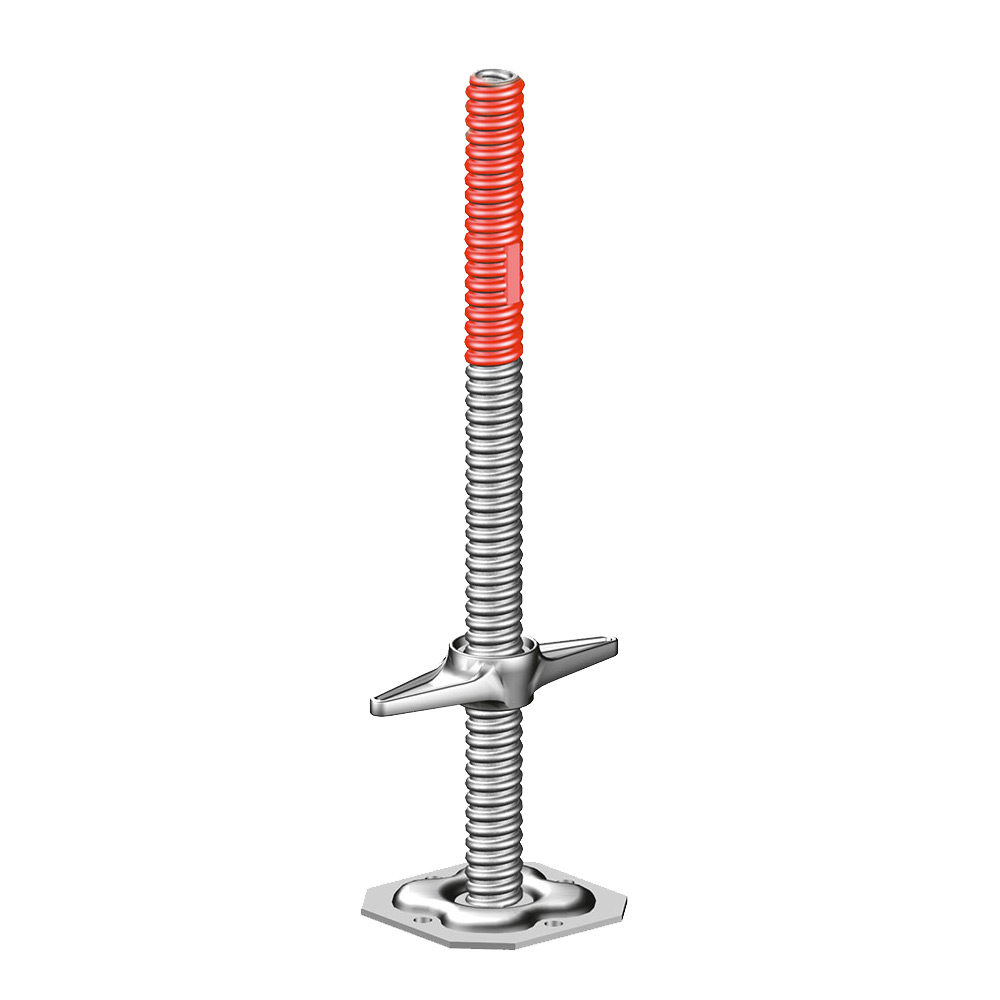Adjustable Base Jack
Model No. FCF02
- The Adjustable Base Jacks are made of steel plate and screw jack.
- These fittings are available in two types (Hollow and solid).
- These Jacks provide a method of adjustment for Cuplock structure. It fits directly into the Cuplock Standard.
- The base plate at the bottom provides stability to the structure.
- The adjustable threaded pipe is made of 4mm thick steel pipe with 38mm OD.
- The adjustable threaded pipe has a nut restraint for adjustment and also to ensure the stem always has a minimum engagement inside the standard of upto 150mm.
- The adjustable base jacks provide 500mm of thread adjustment.
Base jack in Saudi Arabia
In the realm of construction and civil engineering, the base jack is a critical component often used in various structural applications. Whether it's for scaffolding, shoring, or other temporary structures, base jacks play an essential role in ensuring safety and stability. This article delves into the fundamentals of base jacks, including their types, applications, benefits, and installation procedures.
What is a Base Jack?
A base jack, also known as a base plate jack, is a mechanical device designed to support and stabilize structures during construction. It typically consists of a vertical screw mechanism that allows for height adjustment and a base plate that distributes the load evenly across the ground. Base jacks are primarily used in scaffolding systems and temporary structures to provide a stable foundation.
Components of a Base Jack
- Base Plate: This is the part of the base jack that rests on the ground or floor. It is usually made of steel and is designed to distribute the load over a larger area to prevent sinking or instability.
- Vertical Screw: The vertical screw is the mechanism that allows for height adjustment. It is usually threaded and can be rotated to extend or retract the height of the base jack.
- Adjustable Nut: This component is used to lock the vertical screw in place once the desired height is achieved. It ensures that the base jack remains stable and secure.
- Support Plate: Sometimes, base jacks are equipped with a support plate that provides additional stability and strength to the structure.
Types of Base Jacks
Base jacks come in various types, each designed for specific applications:
- Scaffolding Base Jacks: These are used in scaffolding systems to support the weight of the scaffold and any additional loads. They are adjustable to ensure the scaffolding remains level on uneven ground.
- Shoring Base Jacks: Shoring base jacks are employed to support temporary structures, such as formwork for concrete pours. They help prevent the formwork from collapsing under the weight of the wet concrete.
- Falsework Base Jacks: Falsework base jacks are used in temporary support structures for bridges, arches, and other large-scale projects. They provide stability during the construction phase.
- Temporary Support Jacks: These are versatile base jacks used for various temporary support applications, including repairing or renovating existing structures.
Applications of Base Jacks
Base jacks find extensive use in a variety of construction applications:
- Scaffolding: In scaffolding systems, base jacks provide the necessary support and stability. They are crucial for ensuring that the scaffold remains level and secure, especially on uneven or sloped ground.
- Shoring and Formwork: During concrete pours, shoring base jacks support formwork to ensure that it can withstand the weight of the wet concrete. This helps prevent deformation or collapse.
- Bridge Construction: In bridge construction, falsework base jacks are used to support temporary structures and ensure stability during the construction of the bridge's permanent supports.
- Repair and Renovation: Base jacks are used in repair and renovation projects to support existing structures temporarily. They help stabilize the structure while repairs or modifications are made.
Benefits of Using Base Jacks
The use of base jacks in construction offers several advantages:
- Versatility: Base jacks are highly versatile and can be used in a wide range of applications, from scaffolding to shoring and temporary support.
- Adjustability: The height-adjustable feature of base jacks allows for precise leveling, even on uneven or sloped ground. This ensures that structures remain stable and secure.
- Load Distribution: Base jacks are designed to distribute loads evenly across the base plate, reducing the risk of localized stress and potential failure.
- Safety: By providing a stable foundation and support, base jacks contribute to the overall safety of construction sites. They help prevent accidents and structural failures.
- Ease of Installation: Base jacks are relatively easy to install and adjust, making them a convenient choice for temporary support applications.
Installation and Use
Proper installation and use of base jacks are crucial for ensuring safety and stability. Here are the key steps involved:
- Site Preparation: Before installing base jacks, ensure that the ground or floor is level and stable. If necessary, use additional support measures to prepare the site.
- Placement: Position the base jacks in the required locations according to the design and load requirements. Ensure that the base plates are properly aligned and in contact with the ground.
- Adjustment: Use the vertical screw mechanism to adjust the height of the base jacks. Ensure that the structure or scaffold is level and that the base jacks are supporting the load evenly.
- Locking: Once the desired height is achieved, use the adjustable nut to lock the vertical screw in place. This prevents movement and ensures stability.
- Inspection: Regularly inspect the base jacks during use to ensure that they remain stable and secure. Check for any signs of wear or damage and address any issues promptly.
Maintenance and Safety Considerations
Proper maintenance and safety practices are essential for the effective use of base jacks:
- Regular Inspection: Periodically inspect base jacks for signs of wear, damage, or corrosion. Replace any damaged components promptly.
- Load Limits: Adhere to the specified load limits for base jacks to prevent overloading and potential failure. Consult manufacturer guidelines for load capacities.
- Proper Training: Ensure that personnel involved in the installation and use of base jacks are properly trained and familiar with safety procedures.
- Site Safety: Maintain a safe construction site by following best practices for site preparation, installation, and use of base jacks.
Conclusion
Base jacks are indispensable tools in the construction industry, providing essential support and stability for various structural applications. Their versatility, adjustability, and load-distribution capabilities make them a valuable asset in scaffolding, shoring, and temporary support systems. By understanding their components, types, applications, and proper installation procedures, construction professionals can ensure the safe and effective use of base jacks, contributing to the overall success of construction projects.
Specifications
Adjustable Base Jack
|
Video
Currently Unavailable
3D Display
Currently Unavailable


